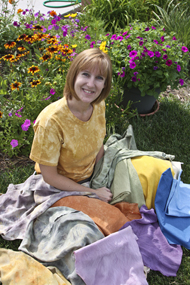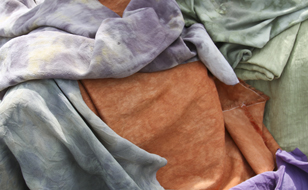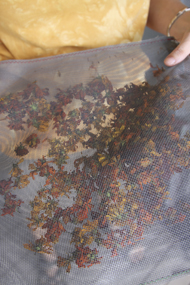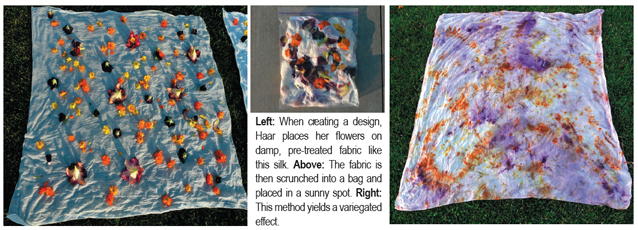K-STATE PROFESSOR RESEARCHES THE 'ART' OF SUSTAINABILITY IN HER OWN BACKYARD
 Tall, vivid stands of flowers bloom in the beds surrounding Sherry Haar's Manhattan home. The plants are inspirational, to say the least, and are for more than just looking at, according to the Kansas State University associate professor of apparel, textiles and interior design.
Tall, vivid stands of flowers bloom in the beds surrounding Sherry Haar's Manhattan home. The plants are inspirational, to say the least, and are for more than just looking at, according to the Kansas State University associate professor of apparel, textiles and interior design.
They are her research.
Haar grows a wide variety of plants, from the common marigold to ancient plants like weld and indigo, for their dye properties. She extracts the color from the flowers, leaves or roots onto fabric that has been prepared to increase the bond between dye and fiber. The plant parts can be used fresh, or dried or frozen for later use.
As a member of K-State's Apparel, Textiles and Interior Design Sustainability Team, Haar is researching what plant/fiber combinations reap the best colorfast results and how to incorporate sustainable methods in the dye process and product development. Each fabric she dyes is its own experiment, which she keeps fastidious track of in a three-ring notebook, complete with fabric swatches and a photo journal.
"I love this work because I can stimulate both sides of my brain through science and design," she said.
Haar has been conducting the research for three years. She spent the first year familiarizing herself with the best practices for natural dyeing. The next year, she began experimenting with solar and decomposition dyeing and using alternative fibers like bamboo, hemp and organic cotton.
Haar said natural dyes can yield virtually any color, though at times she's been surprised by the results. Boldly colored flowers may not yield strong colors, while a delicate bloom may give an intense color. There are many variables that influence the color, such as the method used to extract the color, chemical composition of the plant, fiber and which mordant is used to bind the dye to the fabric, she said.
 This year, Haar has grown more plant varieties, bringing the total around the house to roughly 30, and has been working on creating unique color effects by placing plants on the fabric itself. As an artist, Haar said she believes it's important to incorporate the essence of the plant used into the ultimate design.
This year, Haar has grown more plant varieties, bringing the total around the house to roughly 30, and has been working on creating unique color effects by placing plants on the fabric itself. As an artist, Haar said she believes it's important to incorporate the essence of the plant used into the ultimate design.
"As an artist it is fulfilling to be involved in the design process from the nurturing of a seed to an artwork or product," she said.
To date, Haar has produced a wide variety of colors, from soft purple and orange hues to bolder shades of blue and yellow.
"What I particularly enjoy is the colors you get. They can be strong but they're not acidic like many synthetic dyes," she said. "The palette is more muted, yet there is depth and richness to the color."
Natural dyeing also leaves behind little waste as it uses organic matter exclusively, Haar said.
"More and more people are becoming aware of the toxins and dangerous effluents from synthetic dyes," Haar said. "Using a plant or animal dye source can benefit, rather than harm, the environment."
Taking the tenets of sustainability even further, Haar and her colleagues have been designing garments with little or no fabric waste.
 "We've been experimenting with ways to take a length of fabric, dye it and then create designs with minimal waste that still flatters the wearer," she said. The types of garments being designed could not only be worn in many ways, but would fit people of varying size.
"We've been experimenting with ways to take a length of fabric, dye it and then create designs with minimal waste that still flatters the wearer," she said. The types of garments being designed could not only be worn in many ways, but would fit people of varying size.
Haar said that the other members of the sustainability team and graduate students are researching consumer and market-related aspects of naturally dyed products, as well as the dyestuffs with which to create such products.
Haar said that natural dyes will never replace synthetics, but there are niche markets to be found. And some countries in Europe are interested enough that they've been looking at how much land they would need to grow crops for dyeing and how traditional agricultural equipment could be modified to take on the task.
"There is this worldwide awareness, and I believe Kansas has much to offer in the research and development of natural dyes and by-products," Haar said.
Haar's research is also multidisciplinary. Though she has graduate students in her discipline working on a variety of related projects, she's also working with professors in the department of horticulture, forestry and recreation resources. In addition, K-State's student farm now grows dye plants.
The other members of K-State's Apparel, Textiles and Interior Design Sustainability Team are Barbara Anderson, associate professor; Jana Hawley, professor and department head; Melody LeHew, associate professor; and Kim Hiller Connell, assistant professor.
